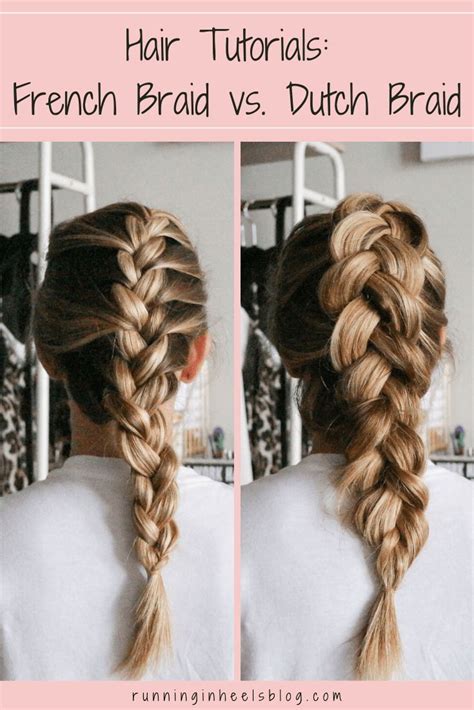Introduction
Braids are timeless hairstyles that add elegance and versatility to any look. Among the most popular braid styles are French braids and Dutch braids. While both create intricate and eye-catching designs, they offer distinct characteristics that set them apart. This comprehensive guide delves into the world of French vs Dutch braids, empowering you to choose the perfect style for your personal aesthetic and hair type.

A Tale of Two Braids
French Braids
Originating in France during the 19th century, French braids are distinguished by their underhanded weaving technique. The three strands of hair are crossed under the middle strand, creating a neat and intricate design. The braid lies close to the scalp, adding a sleek and polished touch to the overall look.
Characteristics:
- Underhanded weaving technique
- Crosses strands under the middle strand
- Lies close to the scalp
- Creates a sleek and polished finish
Dutch Braids
Also known as inside-out or inverse braids, Dutch braids emerged from the Netherlands. They employ an overhanded weaving technique, resulting in a textured and voluminous appearance. The three strands are crossed over the middle strand, with the braid sitting raised above the scalp like a crown.
Characteristics:
- Overhanded weaving technique
- Crosses strands over the middle strand
- Sits raised above the scalp
- Exhibits a textured and voluminous appearance
Choosing the Right Braid
Selecting the most flattering braid style depends on your hair type, facial features, and desired look.
Hair Type:
- French braids are suitable for all hair types, from thin to thick.
- Dutch braids are best suited for thick and voluminous hair.
Facial Features:
- French braids accentuate the face’s natural contours, making them ideal for oval and heart-shaped faces.
- Dutch braids add width to the face, complementing round and square faces.
Desired Look:
- French braids provide a polished and sophisticated look.
- Dutch braids create a more playful and voluminous style.
Step-by-Step Braiding Guides
French Braid
- Brush hair to remove tangles.
- Divide hair into three equal sections.
- Cross the right strand over the middle strand.
- Cross the left strand over the new middle strand.
- Continue underhanding weaving until desired length is reached.
- Secure with an elastic band.
Dutch Braid
- Brush hair to remove tangles.
- Divide hair into three equal sections.
- Cross the right strand under the middle strand.
- Cross the left strand under the new middle strand.
- Continue overhanding weaving until desired length is reached.
- Secure with an elastic band.
Tips for Perfect Braids
- Section hair thoroughly before braiding.
- Use a light hairspray to tame flyaways.
- Pull strands taut while braiding for a secure hold.
- Don’t braid hair too tightly to avoid tension headaches.
- Experiment with different braid sizes and textures.
Variations on the Braid
Beyond classic French and Dutch braids, there are numerous variations to choose from:
- French Braid Crown: Braided headband that encircles the head.
- Double Dutch Braids: Two Dutch braids that meet at the nape of the neck.
- Fishtail Braid: Braid made by weaving fine strands of hair together.
- Milkmaid Braid: Dutch braid wrapped around the head like a crown.
- Messy Braid: Loosened braid for a casual and bohemian look.
Braids in Beauty and Fashion
Braids have been a mainstay in beauty and fashion for centuries. From ancient Egyptian queens to modern-day celebrities, intricate braids have adorned the heads of women around the world. Here are some examples of how braids continue to inspire style:
- Couture Catwalks: Designers such as Chanel and Dior have incorporated braids into their haute couture collections.
- Bridal Hair: French and Dutch braids are popular choices for wedding hairstyles, adding a touch of elegance and romance.
- Festival Fashion: Braided hairstyles are synonymous with music festivals, expressing a bohemian and free-spirited vibe.
- Street Style: Braids have become a ubiquitous trend in street fashion, adding texture and interest to casual and chic outfits.
Benefits of Braiding
Braiding offers numerous benefits for hair health and style:
- Prevents Breakage: Braids protect hair from damage caused by excessive brushing, styling, and environmental factors.
- Promotes Hair Growth: Gentle braiding stimulates blood flow to the scalp, promoting hair growth.
- Reduces Frizz: Braiding helps tame unruly hair, reducing frizz and flyaways.
- Adds Volume: Dutch braids create instant volume and texture to fine or limp hair.
- Versatile Styling Option: Braids are endlessly versatile, allowing for a wide range of formal and casual looks.
Conclusion
French and Dutch braids are versatile and timeless hairstyles that offer a range of possibilities. Whether you prefer the sleek elegance of a French braid or the voluminous texture of a Dutch braid, there is a braid to suit every hair type, face shape, and occasion. Embrace the beauty and practicality of braids, and add a touch of style to your next hairdo.
Additional Resources:
- American Braiding Association: https://americanbraidingassociation.com/
- Braided Hairstyles for Every Occasion: https://www.hairstylesforwomen.com/braided-hairstyles/
- The History of Braids: https://www.mybraids.com/blog/history-of-braids/
